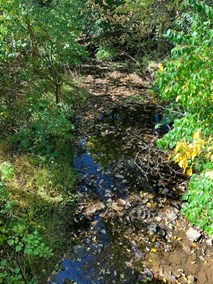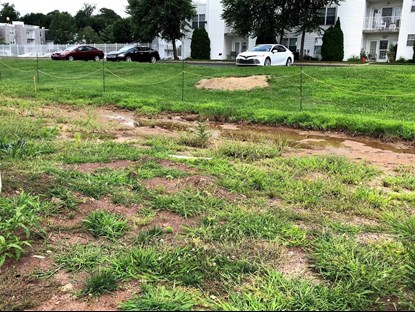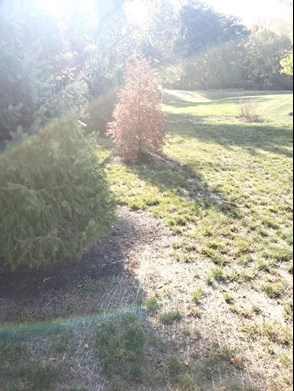Stormwater Management
Stormwater Management- Discharging Water from Pools, Spas, and Hot Tubs
There are many pool owners in Lower Gwynedd Township. As is typically the case, many pool owners who live in cooler climates drain their swimming pools before winter to reduce maintenance and potential damage from freezing. When it enters surface waters, water treated with chemicals such as chlorine, bromine and salt, harms local water quality and is toxic to wildlife and fish. Pools, hot tubs, and fountains often use chemically treated water; however, most of the chemically treated water discharged into storm sewer systems—and ultimately water bodies—is from residential swimming pools. Illicit discharges should not be directed into the municipal separate storm sewer system (MS4). The PA Department of Environmental Protection (PADEP) has a published fact sheet that provides guidance regarding appropriate discharge practices. Instead of discharging chemically treated water to the storm sewer system or directly into local waterways, individuals should follow alternative discharge options, such as draining to a sanitary sewer, dechlorinating water, and then discharging to storm sewers, or dechlorinating water and using it for irrigation. Below is a link to the suggested discharge practices from the PADEP factsheet.
Help keep our waterways clean!
Stormwater runoff pollution is one of the greatest threats to our region’s waterways. Runoff occurs when rain or melted snow flows over impervious surfaces such as driveways, sidewalks, and streets. Rather than soaking into the earth, this runoff picks up litter, chemicals, and other pollutants and gets diverted quickly into storm drains. This runoff is often discharged directly into the waterways we use for swimming, fishing, drinking water and more. Please help us keep our waterways clean – streams in our township flow all the way into the ocean! From the local streams > Wissahickon Creek > Schuylkill River > Delaware River > Delaware Bay > Atlantic Ocean!
Follow these tips to do your part:
- Never dump anything down a storm drain. Always recycle used oil, antifreeze and other fluids.
- Fix oil leaks in your vehicles.
- Wash your car at a commercial car wash rather than in the street or in your driveway.
- Limit or completely eliminate the use of fertilizers on lawns and salt on walkways and driveways
- Keep a tight lid on your trash cans and recycling bins, especially during windy days
Storm drain marking is an educational program designed to inform communities about the problems caused by stormwater runoff, disposing of pollutants improperly, or dumping pollutants into storm drains. Improper disposal of pollutants has a detrimental impact on our waterways and water quality.
Stormwater runoff is generated when precipitation from rain and snow melt events flow over land and impervious surfaces and does not infiltrate into the ground. The runoff from streets, lawns, farms, and construction and industrial sites pick up fertilizers, dirt, pesticides, oil, grease and many other pollutants and discharge into our lakes, streams and rivers. This untreated discharge is detrimental to our water quality as it can adversely affect our drinking water supply and environment. Many Best Management Practices (BMP's) such as detention/retention/infiltration basins, are already in place to help keep our water clean.
Lower Gwynedd Township regulates stormwater management which goes above and beyond typical BMP's through a permit that is obtained from the Pennsylvania Department of Environmental Protection (PA DEP) through the National Pollution and Discharge Elimination System Phase II (NPDES)/Municipals Separate Storm Sewer System (MS4). This is a Federal requirement from the United States Environmental Protection Agency (USEPA) that is administered by the State. This NPDES Permit is broken up into six minimum control measures to be regulated and enforced by the Township. These minimum control measures include:
- Public Education and Outreach
- Public Participation/Involvement
- Illicit Discharge, Detection and Elimination
- Construction Site Runoff Control
- Post-Construction Runoff Control
- Pollution Prevention / Good Housekeeping
Lower Gwynedd Township has begun monitoring and testing of storm sewer outfalls that have flow during dry periods. The township asks all residents to cooperate with the inspectors, as some outfalls are located on private properties.
For any questions or concerns regarding stormwater or to report illicit discharges to the storm sewer system please call the Township at (215) 646-5302.
Also, please visit DEP's website to learn about changes to the MS4 Program.
There are many ways you can help the Township with its stormwater program and participate in volunteering programs that will keep trash, debris and other pollutants out of the storm sewer system. For more information on ways you get involved with your community, please visit the following sites:
- PA DOT: Adopt-A-Highway
- Wissahickon Valley Watershed Association
- DVRPC: Implementing Municipal Water Quality Actions
- DEP Stormwater Smart
The following links are for informational stormwater resources where you can find information on basin retrofits, rain gardens and saving streams.
Houston Creek Stormwater Study
The Township Engineer has completed the Houston Creek Stormwater Study. You can access the final report here. Below is a summary of the grant funded study along with the public presentation that was given prior to the issuance of the final report.
Lower Gwynedd Township received grant funding to conduct a flood study in 2021 through the PA Department of Community and Economic Development's Flood Mitigation Program to conduct a flood study. The project area is located on the border of Lower Gwynedd Township, Ambler Borough and Whitpain Township between the Wissahickon School District property and the Ambler Yards Business Campus. The primary locations that were analyzed are the existing stone/concrete dam and a portion of the creek between Brookside & Marion Avenue from Knight Road to N. Spring Garden Street.
Houston Creek runs northeast to southwest and flows through the School District property to an existing dam. The drainage area to the dam is approximately 123 acres and extends to Mount Pleasant Avenue (east), Houston Road (west), and across Bethlehem Pike (north) on either side of Alene Road, just north of Hamilton Road. Once the flow continues past the dam, it crosses under Knight Road and flows along the front and rear yards of approximately 25 homes on Brookside and Marion Avenue. The creek then flows into a culvert under Spring Garden Street and through existing pipes under the Ambler Yards Business Campus until it reaches the culvert at the railroad tracks, and ultimately discharges into the Wissahickon Creek. The Ambler Yards Campus holds approximately 28 business that are affected in extreme rain events.
The goal of this study was to evaluate possible modifications to the dam or other improvements that could be made to effectively reduce the rate and volume of water reaching the neighborhood to the south of Knight Road and the Ambler Yards Business Campus. Recommended improvements from the final study include:
- Replace driveway bridge blocking stream flow with box culvert (Priority Level 1)
- Re-profile Knight/Francis intersection (Priority Level 1)
- After intersection re-profiling, evaluate roadway drainage improvements (inlets, pipes, re-grading intersections, etc.) within areas of Knight, Francis, Brookside (Priority Level 1)
- Explore partnership with Wissahickon School District and seek grants for construction of new basin at corner of Houston & Knight Road and retrofit of existing basin near admin building. (Priority Level 2)
- Explore partnership with Wissahickon School District for expansion of existing dam or development of additional stormwater detention, volume reduction, or water quality BMPs elsewhere on WSD Campus. (Priority Level 3)
- Engage PennDot regarding ongoing maintenance of Spring Garden Street culvert (Priority Level 3)
Stormwater Presentation
The presentation linked below was given to the Lower Gwynedd Township Board of Supervisors at their public meeting on Tuesday, April 30th, 2024. The presentation gives a brief overview of the MS4 permit requirements for the Township and also information about the stormwater strategic plan we are finalizing that addresses stormwater management township wide.
Streambank Restoration Project- Township Awarded Grant
Lower Gwynedd Township is pleased to announce that the Old Bethlehem Pike Streambank Stabilization & Enhancement Project was approved for a Watershed Restoration Protection Program Grant at the April 21, 2021 Community Financing Authority (CFA) Board meeting in the amount of $100,000.00. The Pennsylvania Department of Community and Economic Development's Watershed Restoration & Protection Grant Program is funded through monies allocated under Act 13 of 2012, the Marcellus Legacy Fund. The CFA is an independent agency of the DCED responsible for administering Pennsylvania’s economic stimulus packages.
This project will repair eroded streambanks within the Willow Run tributary to the Wissahickon Creek. The project stream segment is located off of Old Bethlehem Pike directly behind the Lower Gwynedd Township Municipal Building. The scope of this project includes the stabilization and enhancement of approximately 300 linear feet of stream (both sides) from 100 feet upstream of the Old Bethlehem Pike bridge and 200 feet downstream. The restoration work will re-establish and stabilize the bank and restore the area to its natural function. The project will help control erosion in the future and protect the streambank. We also anticipate that the restoration and enhancement will reduce the amount of sediment and other pollutants from entering the stream and improve water quality throughout the watershed. This project is also receiving funding through Montgomery County ARPA as it was part of an application made by the Wissahickon Clean Water Partnership who are working to finalize a water quality improvement plan that will serve as an alternative TMDL. The project will begin in the summer of 2024.

A Tale of Two Townships
A coalition of municipalities, local and state agencies, NGOs, and citizens is working on a plan to clean up Montgomery County's impaired Wissahickon Creek. The Wissahickon Creek has been designated an impaired waterway. The coalition has come together under an Intergovernmental Cooperation Agreement to address the challenge. Collectively known as the Wissahickon Clean Water Partnership, the partnership has teamed with Temple University and other experts to help identify the watersheds impairments. In the third of a series of interviews with the Pennsylvania Environmental Council (PEC) our own Mark Grey, Lower Gwynedd Township Supervisor, and Upper Dublin Township Manager Paul Leonard, Co-Chairs of the Wissahickon Clean Water Partnership, sat down for a conversation with longtime radio journalist, Josh Raulerson formally from Pittsburgh NPR station 90.5 WESA. Click here to listen to the interview.
Clean Water Partnership-Wissahickon TMDL Alternative
The Wissahickon Creek is beloved to our community, flowing through our landscape from Lansdale to Philadelphia. In 2016, the municipalities of the Wissahickon Creek Watershed joined together to form an unprecedented coalition of towns and sewer authorities working with the Pennsylvania Department of Environmental Protection (PADEP) and the US Environmental Protection Agency (USEPA) to address the long-term health of the creek. This coalition, called the Wissahickon Clean Water Partnership, has been working together with the regulatory agencies over the past eight years to finalize a water quality improvement plan that is a shared strategy to “Own the Solution” for a cleaner Wissahickon Creek.
This voluntary partnership is evaluated the causes of polluted waters and produced a watershed-wide plan to address those causes and make significant improvements to the health of the creek over the coming years. By working together on a coordinated solution, the Wissahickon Clean Water Partnership ensures that local interests are emphasized, that no municipality is alone in combating pollution affecting the Wissahickon, and that municipalities, sewer authorities and taxpayers can keep costs down in the long run.
Stormwater Article
Keep Your Soil at Home
Believe it or not, one of the biggest threats to our water quality is plain old dirt washing into our rivers from lawns, roads, driveways, and construction sites. The top soil is an important resource for your yard. However, when the soil is lost through erosion it becomes a pollutant called “sediment.” Water flowing from your yard during rain or snow melt carries sediment, and the other pollutants that attach to sediments, to our local streams.

What’s Wrong with Sediment?
Sediment clouds and reduces sunlight for stream plants that provide habitat and oxygen for fish. Sediments fill in the spaces between rocks in stream bottoms and take away fish habitat and habitat for other critters that live on the bottom. Sediment also carries other pollutants such as nutrients, oil, and grease. Excess nutrients in water lead to nuisance algae growth.
Signs of Erosion Include:
- Exposed tree roots, stones, and rocks
- Formation of small gullies
- Buildup of soil in low areas
- Widening or depending stream channels

What can you do to prevent erosion?
- Seed or mulch any bare soil on your property. Plant roots guard soil from rain drops and prevent erosion.
- Choose native plants that thrive in our climate. Native plants can grow deeper roots systems that protect soil from erosion. Check with a local nursery for information.
- Cover gardens with mulch or leaves over winter to protect plants and reduce erosion when snow melts.
- If you observe erosion at construction sites, contact Township Administration at 215-646-5302.
Stormwater Management Updates
GROWING GREENER BASIN NATURALIZATION PROJECT- PHASE 2
Lower Gwynedd Township completed Phase 2 of the Basin Naturalization Project, which was funded through the Growing Greener Grant. The two Township-owned basins located in the open space area of the Spring House Farms Development were retrofitted as part of this stormwater management project. The slideshow below was presented by the EAC to give a background and overview of the entire project.
Tips for Residents
For More Information, Please visit:
- USEPA
- USEPA Stormwater Basic Information
- USEPA Stormwater Program
- USEPA Stormwater Discharge From MS4's
- USEPA Stormwater Outreach Materials and Reference Documents
- PA DEP
- PA DEP Southeast Region Office
- PA DEP Stormwater Management Program
- (MCCD) Montgomery County Conservation District
- (FEMA) Federal Emergency Management Agency
- (CWP) Center for Watershed Protection
- PA Environmental Council